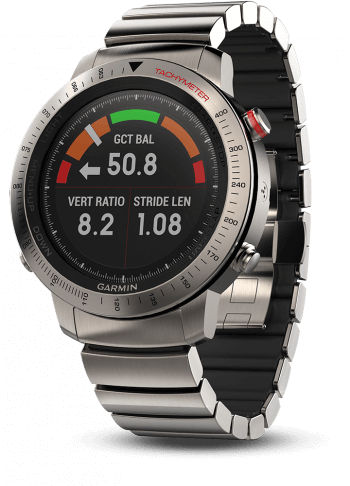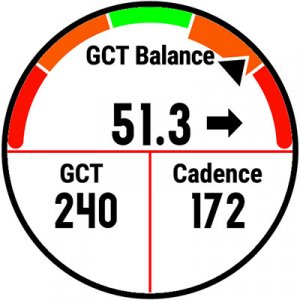Why Does Ground Contact Time Matter?

Watch the world’s fastest runners and it will look like their feet barely touch the ground.
It makes sense, doesn’t it? The quicker your feet are moving, the less time they actually spend on the ground.
A higher leg turnover naturally leads to a decrease in your ground contact time. A metric you should pay attention to if you’re looking to improve your running speed.
What Is A Good Ground Contact Time?
Ground Contact Time (GCT) is the measure of time your foot is in contact with the ground on each step. Measured primarily in milliseconds (ms), the average running ground contact times are anywhere from 160 to 300 milliseconds.
Elite runners spend less than 200 milliseconds in contact with the ground.
What Factors Impact Ground Contact Time?
- Power impacts your GCT. In other words, how quickly can you apply force to the ground?
- Footstrike also impacts your GCT. A stiff leg at the moment your foot strikes the ground equals more “free” energy.
- Biomechanics is also important. Having proper form can save you milliseconds in many areas, including GCT.
These three things mean that you can train your body to have less GCT, which is optimal for faster running.
Stages Of Ground Contact Time

GTC can be divided into four stages;
- Initial contact
- Braking
- Mid-stance
- Propulsion
Let’s break that down. We have all seen them… those amazing action photos where both of a runner’s feet appear to be floating above the ground. As you transition from that float phase, one of your feet touches the ground. That is initial contact. No matter how you impact, whether it is with your heel, forefoot, or midfoot, that marks the beginning of the stance phase.
That impact moves you into absorption or braking. Managing this controlled landing properly helps you to have a shorter contact time if you are doing things in ways that are advantageous from a biomechanical perspective.
This braking phase happens until that foot that has made contact has passed under your body. In this “single support phase,” your body weight has been placing its full impact on that single foot. (Also known as mid-stance phase).
After that leg has made a full controlled landing, the propulsion stage happens. Propulsion is when you hit the “toe-off” as you push off of the ground. Also known as ground reaction forces.
Once complete, you have made a full gait cycle and are back to floating above the ground!
How To Calculate Ground Contact Time?

Cadence and ground contact time are married, so to speak. As cadence increases, ground contact time decreases.
In a perfect world, the runner would be well balanced, meaning that the time of contact of each foot is the same.
Velocity = contact length/ground contact time. Closely tied to cadence, or the number of steps a runner takes in one minute, and vertical oscillation, which is the height of a person’s vertical bounce, GCT measures exactly how much time a foot is in contact with the ground. This is from foot strike to toe-off.
Garmin running watch has added a GCT feature, complete with a display of which foot is on the ground longer. Remember: ideally, they are equal.
But this all sounds too difficult to track without a little help from technology. Here are a few options to consider that will provide accurate Ground Contact Time and Vertical Oscillation tracking;
The Best Garmin Running Watches
How To Improve Running Ground Contact Time?
The most simple way to improve your ground contact time is to incorporate striders into your workout at least once each week. What are striders? These are super short bursts of speed. You do 10-15 intervals of 10-20 seconds each at your maximum speed. Working leg turnover helps you to improve your GCT.
Another tactic is to identify asymmetry so you can work on balancing these things out. If you try to stand on one leg, for example, can you stand longer on one than the other? If you can’t balance on both sides equally, you need to work on that. You should focus on improving your symmetry in all aspects possible. This means strength training, balance, flexibility, etc.
Strengthening muscles is also important if you want to improve your GCT. Developing your musculature strength and power should result in speed. In addition to strengthening your muscles, you need to work to develop your flexibility. That was mentioned before in regards to symmetry, but don’t make the mistake of thinking it is only important as an equalization factor. Flexibility is important for everyone trying to improve their ground contact time.
If you have any lingering injuries, get those taken care of. Allowing injuries to fester and go untended can make for more problems down the road. Injured athletes tend to favor that body part, which can make more pain. Don’t let that happen!
What’s The Difference Between Ground Contact Time & Flight Time?
Flight Time refers to the amount of time a runner spends off the ground between strides.
Put short, it’s the exact opposite of Ground Contact Time.
When tracked and optimized in tandem with Ground Contact Time, runners can greatly improve their speed.
Does Ground Contact Time Matter?
You’re probably asking yourself, is this an insignificant running performance metric that sprinters and the top distance runners focus on? Why should an average runner care about those deep exercise science factors like GTC?
Well, when you look at the entire picture of your gait cycle, it can make a very large difference.
Perhaps a better way to frame GTC is within the goal of “running efficiency”. Whether you’re a couch to 5K beginner or advanced marathoner, running technique can have major effects on all aspects of performance.
All of these little things can add up to improve your running economy, making you a healthier and happier runner.
And honestly, at the end of the day, isn’t that something we all want?
Sources
Latest Articles
 Is Running on a Treadmill Easier Than Running Outside?Runners have their own preferences, whether it is treadmill running, running outside on the road, or exploring trails. So...
Is Running on a Treadmill Easier Than Running Outside?Runners have their own preferences, whether it is treadmill running, running outside on the road, or exploring trails. So... Is It OK to Use Trail Running Shoes on the Road?While trail running shoes can be used on roads, especially in situations where a runner encounters mixed terrains or pref...
Is It OK to Use Trail Running Shoes on the Road?While trail running shoes can be used on roads, especially in situations where a runner encounters mixed terrains or pref... How to Fix Sore Quads After Running?Rest, ice, gentle stretching, and over-the-counter pain relievers can help soothe sore quads after running. Also, ensure ...
How to Fix Sore Quads After Running?Rest, ice, gentle stretching, and over-the-counter pain relievers can help soothe sore quads after running. Also, ensure ... 10 Fruits With The Most Electrolytes to Replace Sports DrinksThese fruits are high in electrolytes such as potassium, magnesium, and calcium, essential for hydration, muscle function...
10 Fruits With The Most Electrolytes to Replace Sports DrinksThese fruits are high in electrolytes such as potassium, magnesium, and calcium, essential for hydration, muscle function...

